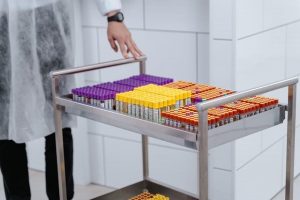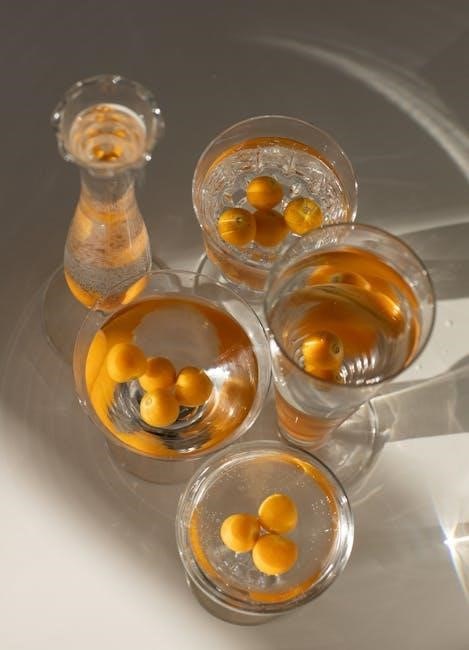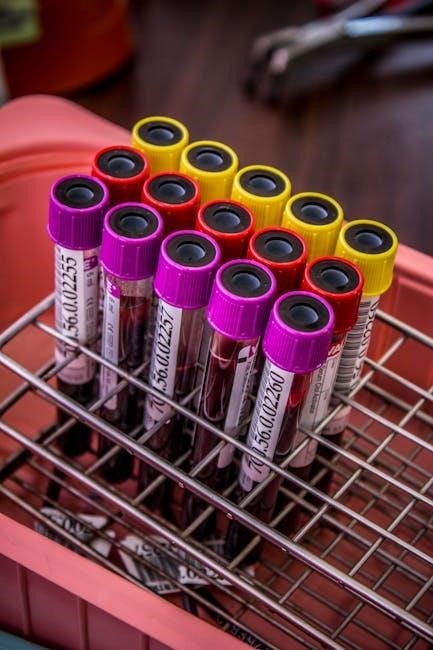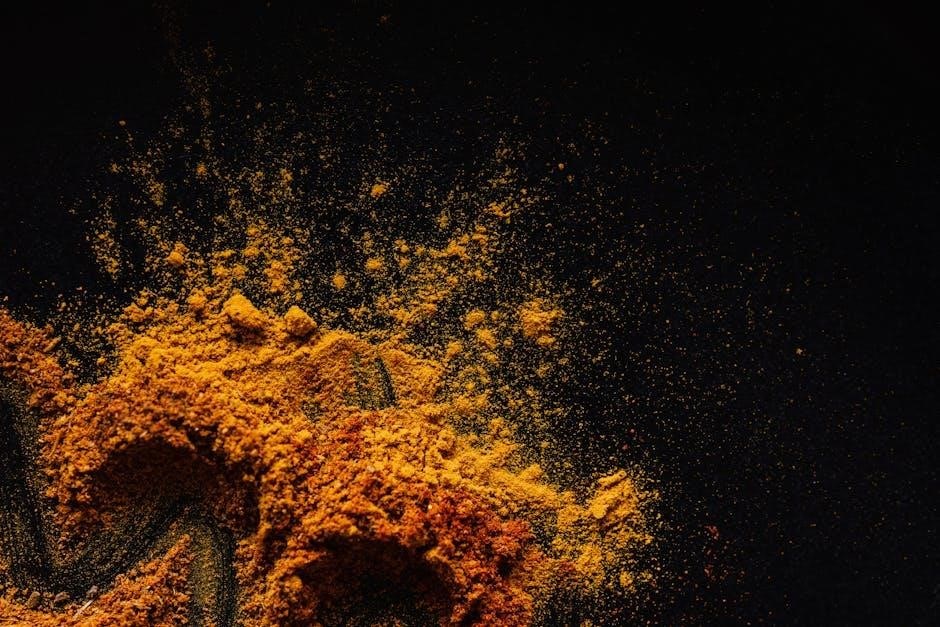color guide blood collection tubes

Blood collection tubes are color-coded to ensure accurate sample collection for specific laboratory tests; Each color represents unique additives or purposes, guiding healthcare professionals in selecting the right tube for various diagnostic procedures. Understanding this system is crucial for maintaining sample integrity and ensuring reliable test results. The color coding simplifies the process, reducing errors and enhancing efficiency in clinical settings. Proper tube selection is essential for patient safety and accurate diagnostic outcomes. This guide provides a detailed overview of the color coding system, its significance, and applications in phlebotomy.
Importance of Tube Colors in Phlebotomy
The color coding of blood collection tubes is critical for ensuring accurate and reliable laboratory test results. Each tube color corresponds to specific additives or no additives, which determine whether blood should clot or remain liquid. Proper tube selection prevents cross-contamination of samples and ensures the correct test is performed. This system minimizes errors, enhances patient safety, and streamlines the diagnostic process. Understanding tube colors is essential for phlebotomists to collect samples correctly, maintaining the integrity of blood specimens for precise analysis and treatment decisions.

Red Blood Collection Tubes
Red blood collection tubes are used for collecting blood samples for various tests, including blood chemistry, serology, and blood bank studies. They contain no additives, allowing blood to clot naturally for serum separation.
Uses and Additives
Red blood collection tubes are primarily used for blood chemistry tests, serology, and blood bank studies. They contain no additives, allowing the blood to clot naturally. This process enables the separation of serum, which is essential for various diagnostic procedures. The absence of additives ensures that the blood components remain in their natural state, providing accurate results for tests such as liver function, kidney function, and infectious disease screenings. Proper handling and clotting times are crucial to maintain sample integrity.

Lavender Blood Collection Tubes
Lavender tubes contain K2 or K3 EDTA, anticoagulants that prevent clotting, making them ideal for hematology tests like CBCs and blood cell analysis.
Role of EDTA in Hematology Testing
EDTA (Ethylene Diamine Tetraacetic Acid) is a critical anticoagulant in lavender tubes, preventing blood clotting by binding calcium ions. This ensures accurate hematology test results by preserving cell integrity. EDTA stabilizes blood cells, preventing shrinkage or swelling, and maintains the viability of cells for analysis. It is essential for complete blood counts (CBCs) and other tests requiring precise cell measurements. Proper mixing of blood with EDTA is vital to avoid clotting and ensure reliable diagnostic outcomes, making it a cornerstone in modern hematology testing.

Light Blue Blood Collection Tubes
Light blue tubes contain sodium citrate, an anticoagulant that prevents clotting for coagulation tests like PT, INR, and fibrinogen. This ensures accurate results for blood clotting assessments.
Sodium Citrate and Coagulation Studies
Sodium citrate is an anticoagulant in light blue tubes, preventing blood clotting for coagulation studies. It chelates calcium ions, essential for clot formation. Common tests include Prothrombin Time (PT), International Normalized Ratio (INR), and D-Dimer. Proper mixing by inverting tubes 8-10 times ensures accurate results. Sodium citrate is ideal for assessing clotting disorders and monitoring anticoagulant therapy. Correct handling ensures reliable outcomes in diagnosing conditions like bleeding disorders or thrombosis. This additive is critical for precise coagulation assessments, making light blue tubes indispensable in clinical settings.

Green Blood Collection Tubes
Green tubes contain sodium heparin, an anticoagulant that prevents clotting for plasma determinations. They are used for tests requiring heparinized plasma or whole blood samples, ensuring accurate results.
Sodium Heparin for Plasma Determinations
Sodium heparin is an anticoagulant in green blood collection tubes, preventing clotting for plasma determinations. It is ideal for tests requiring heparinized plasma or whole blood samples, such as chemistry, immunology, and molecular studies. Sodium heparin inhibits thrombin formation, ensuring accurate results in plasma-based assays. Proper mixing by inverting the tube 8-10 times is essential for even distribution of the anticoagulant. This additive is preferred for tests where clotting must be avoided, making it a critical component in modern laboratory diagnostics for various clinical applications.

Gold (SST) Blood Collection Tubes
Gold tubes contain a clot activator and gel for serum separation, ensuring rapid clotting and clear serum for accurate chemistry and serology tests. Five tube inversions mix additives.
Clot Activator and Gel for Serum Separation
The clot activator in gold tubes accelerates blood clotting, while the gel acts as a barrier, separating serum from blood cells after centrifugation. This ensures clear, contamination-free serum samples for accurate laboratory testing. Proper inversion of the tube five times mixes the clot activator evenly with the blood, promoting efficient clot formation. After centrifugation, the gel moves between the serum and blood cells, preventing hemolysis and maintaining sample integrity. This process is crucial for reliable results in various clinical chemistry tests and serological analyses.

Royal Blue Blood Collection Tubes
Royal blue tubes are used for trace element analysis, containing sodium citrate to prevent clotting and ensure accurate test results in specialized clinical assays.
Trace Element Analysis
Trace element analysis involves measuring concentrations of metals like zinc, copper, and lead in blood. Royal blue tubes, containing sodium citrate, are specifically designed for this purpose. They prevent clotting and ensure accurate test results. Trace elements are essential for diagnosing deficiencies or toxicities, which can impact health conditions like anemia or heavy metal poisoning. Proper collection using these tubes is critical for reliable data, aiding in precise clinical decisions and targeted therapies. Their unique design makes them indispensable in specialized assays.

Tan Blood Collection Tubes
Tan blood collection tubes contain specialized additives for specific tests, such as glucose or lactate determinations. They often include sodium fluoride to inhibit glycolysis, preserving glucose levels for accurate analysis. These tubes are essential for diagnosing metabolic disorders or monitoring glucose levels in clinical settings. Their unique additives ensure reliable results, making them invaluable in targeted diagnostic procedures. Proper use of tan tubes is critical for precise patient care and treatment planning.
Specialized Additives for Specific Tests
Tan blood collection tubes are designed for specialized testing, often containing additives like sodium fluoride to inhibit glycolysis, preserving glucose levels for accurate analysis. These tubes are frequently used for glucose or lactate testing, where maintaining sample integrity is critical. The additives prevent metabolic changes in the blood sample, ensuring reliable results. Proper use of tan tubes is essential for diagnosing conditions like diabetes or metabolic disorders. Their specialized nature makes them indispensable in targeted clinical testing, providing precise data for patient care and treatment decisions.

Yellow Blood Collection Tubes
Yellow blood collection tubes contain Sodium Polyanethol Sulfonate (SPS), an anticoagulant that prevents clotting and preserves blood samples for microbiological cultures and infectious disease testing.
Sodium Polyanethol Sulfonate (SPS) for Blood Cultures
Sodium Polyanethol Sulfonate (SPS) is an anticoagulant used in yellow blood collection tubes to prevent clotting and preserve blood samples for microbiological testing. It inhibits complement, phagocytosis, and lysozyme activity, ensuring accurate detection of pathogens. SPS is ideal for blood cultures, as it supports the growth of bacteria, fungi, and other microorganisms. Proper use of SPS tubes is critical for diagnosing infections and guiding antimicrobial therapy. Always follow the recommended fill volume and handling procedures to maintain sample integrity.

Pink Blood Collection Tubes
Pink tubes contain K2 EDTA, an anticoagulant that prevents clotting and is used for blood typing, cross-matching, and specialized testing. They are essential for ensuring accurate serological results.
K2 EDTA for Blood Typing and Special Tests
K2 EDTA is an anticoagulant in pink blood collection tubes, preventing clotting by binding calcium ions. It is ideal for blood typing, cross-matching, and specialized tests requiring intact blood cells. The additive ensures accurate serological results by preserving cell integrity. K2 EDTA is preferred for its effectiveness in maintaining sample consistency, especially in immunohematology. Proper tube filling and mixing are crucial to ensure the anticoagulant works effectively, avoiding clotting and ensuring reliable test outcomes for critical diagnostic procedures.
Order of Draw in Blood Collection
The standard order of draw ensures sample integrity, starting with blood cultures, followed by light blue, red, gold, green, lavender, and others, preventing cross-contamination and ensuring accurate results.
Standard Protocol for Tube Collection
The standard protocol for tube collection begins with blood cultures, followed by light blue (coagulation), red (serum separator), gold (SST), green (heparin), lavender (EDTA), and others. Tubes must be collected in a specific order to prevent cross-contamination and ensure accurate results. Each tube should be inverted 6-8 times after collection to mix additives with blood. Proper labeling, including patient name and date, is essential. Adhering to this protocol ensures sample integrity, accurate test outcomes, and patient safety. This systematic approach is critical in clinical and laboratory settings.